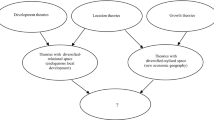Abstract—
A scheme has been developed for assessing the impact of investments on the GRP growth in a region, the country, and the eastern zone of the Russian Federation, based on an analysis of the investment cycle investments–fixed assets–GRP–investments, the movement of the age strata of fixed assets, and their capital productivity. Triple helix models of interaction of the main factors of regional development (GRP, investment, and household income) in a multiregional system are proposed. The method of coordinating the conditions for the development of regions of different hierarchical levels is substantiated, in particular, the correct translation of the key macroeconomic parameters of the country’s economic development to regions. Its interpretation is proposed in terms of the triple helix model based on the center–periphery approach. Algorithms for joint use of the proposed methods in a set of simulated regional macromodels have been developed. The features of the socioeconomic situation of the eastern regions of the Russian Federation have been studied, experimental calculations of the regional development for the period up to 2035 have been performed and analyzed using a moderately optimistic scenario of the growth levels of key parameters of the economy (population size and income, growth in the share of investments in GRP, etc.).




Similar content being viewed by others
Notes
In 2020–2022, in a competition established by the Ministry of Science and Higher Education of the Russian Federation, a consortium of Russian scientific institutes headed by IEIE SB RAS is carrying out the large scientific project “Socioeconomic Development of Asian Russia Based on Synergy of Transport Accessibility, Systemic Knowledge of the Natural Resource Potential, and Expanding Spaces of Interregional Interactions.” The problem of developing a single tool set for macroeconomic, interregional, and intersectoral analysis and forecasting is discussed in (Kryukov et al., 2020). The approaches proposed in the article are aimed at including the regions of the eastern zone with different levels of territorial hierarchy in the systemic calculations. The results have partially been used in research on the project in 2020.
With rare exceptions, construction projects with a construction period of more than three years can always be divided into separate startup complexes that fit these restrictions.
It is just as obvious that the ratio of the productivity of assets of different ages is quite stable over the years of the calculation period, although it can evolve.
Estimated population of the Russian Federation up to 2035 (Statistical Bulletin). Moscow, Rosstat, 2018.
REFERENCES
Capello, R., Caragliu, A., and Fratesi, U., Modeling regional growth between competitiveness and austerity measures: the MASST3 model, Int. Reg. Sci. Rev., 2017, vol. 40, no. 1, pp. 38–74.
Caryannis, E.G., Cherepovitsyn, A.E., and Ilinova, A.A., Sustainable development of the Russian Arctic zone energy shelf: the role of the quintuple innovation helix model, J. Knowl. Econ., 2017, vol. 8, no. 2, pp. 456–470.
Etzkowitz, H. and Leydesdorff, L., The Triple Helix University-industry-government relations: A laboratory for knowledge based economic development, EASST Rev., 1995, vol. 14, pp. 14–19.
Fiani, R., Increasing return, non-traded inputs and regional development, Econ. J., 1984, vol. 94, no. 384, pp. 308–323.
Huggins, R., Jones, M., and Upton, S., Universities as drivers of knowledge-based regional development: a triple helix analysis of Wales, Int. J. Innovation Reg. Dev., 2008, vol. 1, no. 1, pp. 24–47.
Ikegami, M. and Romão, J., Universities and knowledge-based regional development: a comparative study on the triple helix framework in Amsterdam and Sapporo, Stud. Reg. Sci., 2016, vol. 46, no. 1, pp. 101–113.
Krugman, P. and Venabies, A., The Seamless World: A Spatial Model of International Specialization, Cambridge, MA: Natl. Bur. Econ. Res., 1997.
Kryukov, V.A., Baranov, A.O., Suslov, V.I., and Suslov, N.I., Development of a single complex of means of macroeconomic, interregional, intersectoral analysis and forecasting, Ekon. Reg., 2020, vol. 16, no. 4, pp. 1072–1086.
Leydesdorff, L., Synergy in knowledge-based innovation systems at national and regional levels: the triple-helix model and the Fourth Industrial Revolution, J. Open Innovation: Technol., Market, Complexity, 2018, vol. 4, no. 16, pp. 1–13. https://doi.org/10.3390/joitmc4020016
Milne, W.J., Glickman, N.J., and Adams, F.G., A framework for analyzing regional growth and decline: a multiregion econometric model of the United States, J. Reg. Sci., 1980, vol. 20, no. 2, pp. 173–189.
Puga, D. and Venablies, A., The Spread of Industry Spatial Agglomeration in Economic Development: CEPR Working Paper No. 1354, Washington, DC: Center Econ. Policy Res., 1997.
Suspitsyn, S.A., Metody i modeli koordinatsii dolgosrochnykh reshenii v sisteme “natsional’naya ekonomika–regiony” (Methods and Models of Coordination of Long-Term Solution in the System “National Economics–Regions”), Kuleshov, V.V., Ed., Novosibirsk: Inst. Ekon. Org. Prom. Proizvod., Sib. Otd., Ross. Akad. Nauk, 2017a.
Suspitsyn, S.A., SIRENA project: from concept to technology, Reg.: Ekon. Sotsiol., 2017b, no. 4 (96), pp. 25–61.
Suspitsyn, S.A., Regional specification of macroeconomic target parameters for forecasting of the development of Russia, Reg.: Ekon. Sotsiol., 2020, no. 3 (107), pp. 3–29.
Funding
The article was prepared under the state assignment IEIE SB RAS (project “Regional and Municipal Strategic Planning and Management in the Context of Modernization of State Regional Policy and Development of the Digital Economy”).
Author information
Authors and Affiliations
Corresponding author
Ethics declarations
The author declares no conflict of interest.
Additional information
The article has been substantially updated and revised by the author for publication in Regional Research of Russia.
Rights and permissions
About this article
Cite this article
Suspitsyn, S.A. Set of Methods and Procedures for Analyzing and Forecasting the Development of the Eastern Regions of the Russian Federation. Reg. Res. Russ. 11 (Suppl 1), S65–S77 (2021). https://doi.org/10.1134/S2079970522010087
Received:
Revised:
Accepted:
Published:
Issue Date:
DOI: https://doi.org/10.1134/S2079970522010087




